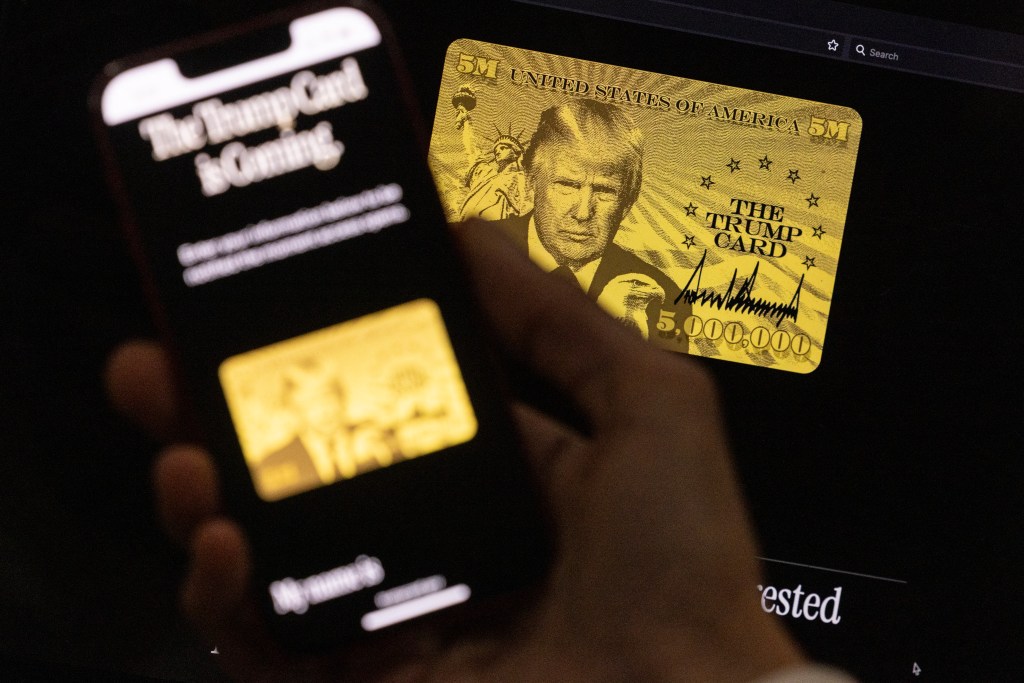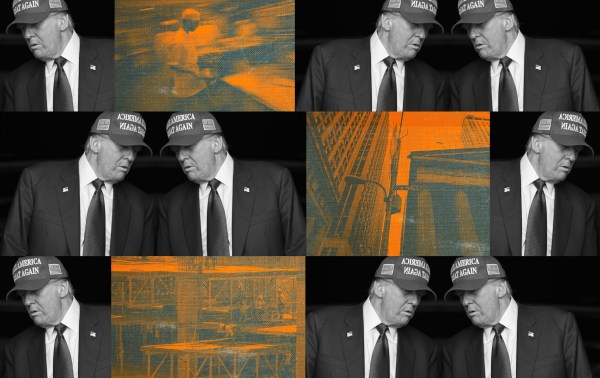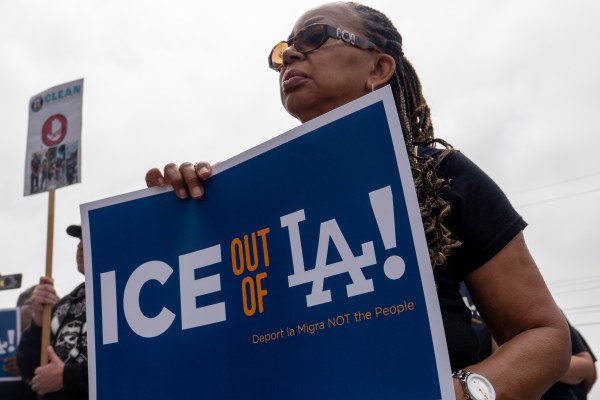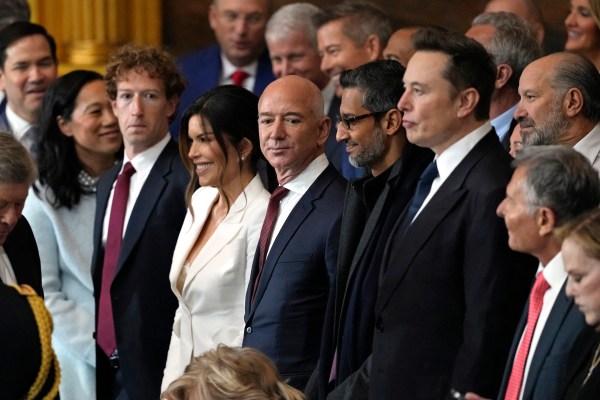Last week, a new official government website appeared—trumpcard.gov—featuring official seals for the president, Department of Commerce, and Department of Homeland Security. “The Trump Card is Coming,” read large golden letters on top of the black background. “Enter your information below to be notified the moment access opens.”
Except, the “Trump Card,” a new visa program pitched by the Trump administration, probably isn’t coming—at least not without action from Congress.
What’s a Trump Card?
In February, President Donald Trump—alongside Commerce Secretary Howard Lutnick—announced in the Oval Office that the administration would begin offering a new visa to wealthy foreigners who want residency and eventually citizenship in the U.S. Trump said that the card, which he initially dubbed the “gold card,” would sell for about $5 million and give individuals all the privileges of a green card—a visa that allows foreigners to live and work permanently in the U.S.—plus a route to American citizenship.
“Wealthy people will be coming into our country by buying this card. They’ll be wealthy and they’ll be successful and they’ll be spending a lot of money and paying a lot of taxes and employing a lot of people,” Trump said during the announcement. “And we think it’s going to be extremely successful. Never been done before, anything like this, but it’s something that we’re going to be putting out over the next two weeks.”
The idea of a high-cost visa for wealthy foreigners was not part of Trump’s 2024 presidential campaign, and reportedly was first floated by billionaire hedge fund manager and Trump donor John Paulson.
According to Lutnick, proceeds from the visa could be used to pay down the federal debt, which stands at approximately $36 trillion. “These are going to be great people who are going to come and bring businesses and opportunity to America, and they’re going to pay $5 million,” Lutnick said last month at an event with Axios. “So if 200,000 people—remember, we give 280,000 visas a year now for free, not counting the 20 million people who broke into this country for nothing under Biden. But 200,000 people who pay, that’s a trillion dollars. That pays for everything.”
Replacing EB-5.
Lutnick is pushing for the Trump Card to replace the existing EB-5 visa—an immigration program that grants permanent residency to foreigners who invest in U.S. commercial enterprises and create jobs in the country. “The EB-5 program is both an investment and a job creation program,” Ron Klasko, managing partner and chairman of Klasko Immigration Law Partners, a law firm that specializes in EB-5 visas, told The Dispatch. “You have to make an investment that is at risk, and you have to show that your investment will create at least 10 jobs for U.S. workers.”
Established by the Immigration Act of 1990 and reformed in 2022, the EB-5 program requires an investment of either $800,000 or $1.05 million into any “for-profit activity formed for the ongoing conduct of lawful business,” according to the U.S. Citizenship and Immigration Services. These figures are pegged to inflation as of 2022, and will adjust in line with growth in the Bureau of Labor Statistics’ Consumer Price Index for All Urban Consumers every five years. The investment must also last for at least two years and create at least 10 full-time jobs for U.S. citizens, lawful permanent residents, or other immigrants authorized to work in the country.
Most EB-5 investments are made through pools where multiple investors combine their money to invest in a single larger commercial enterprise, and, according to Klasko, most applicants come from Asia. “By far, since the program started, the largest number of applicants are from China, by a large amount,” he said. “Second is India. Third is Vietnam.” There is currently an annual limit of approximately 10,000 EB-5 visas, including for family members, and a maximum of 7.1 percent of that limit can go to residents of a single foreign country in any given year.
Legal hurdles.
Despite the live website promoting the program, the White House has yet to offer any details on how it plans to implement the new visa aside from Trump’s statement that “we all have it worked out from the legal standpoint, it’s totally legal to do.” The EB-5 program is codified in the Immigration and Nationality Act (INA), meaning the designation can be changed only by an act of Congress.
“It’s part of the [INA], and it’s just one of the employment-based categories in immigration law,” Klasko said. “So, if you want to change that, or any other law, you need to do it by another law that would amend the program.”
The program would also likely require changes to the U.S. tax code. Typically, U.S. citizens and permanent residents are required to pay taxes on their worldwide income, meaning a wealthy foreigner who decides to pursue U.S. residency or citizenship would need to pay U.S. taxes on money they earn outside of the U.S. Recipients of the Trump Card, however, will reportedly be exempt from this requirement. “The whole premise of the Trump Card is that, unlike all U.S. citizens and all green card holders who are taxed on worldwide income, these folks apparently would not be taxed on worldwide income, which is the only way they’d be interested in the program,” Klasko explained. “And that requires an amendment to the tax code.”
The White House did not respond to questions from The Dispatch about how the administration plans to implement the Trump Card program.
What’s the demand?
It is also unclear just how much demand there would be for the Trump Card, even if it did make it into the country’s immigration laws. Earlier this week, Lutnick told FT that nearly 70,000 people had already registered online for the card’s waiting list. “Basically, everyone I meet who’s not an American is going to want to buy the card if they have the fiscal capacity,” Lutnick said.
However, the waitlist is open to anyone, and there is no indication that all registrants intend to actually pursue the visa should it become available.
David Bier, director of immigration studies at the Cato Institute, thinks there may be substantially less demand than the administration hopes. “The utility of the concept as described is pretty limited, because you’re talking about just handing $5 million to the U.S. government, and you’re not getting any of it back, and there’s no compensation other than you get to live in the United States,” he told The Dispatch. “I just don’t see the market.”
If 200,000 people did participate in the program, however, it could put a dent in the federal deficit. “The Gold Card could surely provide a one-time revenue bump for the Treasury, depending on how many people participate,” Jessica Riedl, economist at the Manhattan Institute, told The Dispatch. “While Howard Lutnick’s prediction of 200,000 participants seems inflated, even 50,000 could provide a one-time infusion of $250 billion. With budget deficits of $1.8 trillion headed to $4 trillion within a decade, that provides a modest one-time offset.”
Bier similarly finds Lutnick’s estimate unrealistic. “That is not believable to me,” he said. “You’re talking about an exponentially higher amount of loss for, same benefit [as the EB-5 program]. I just cannot imagine a scenario where there’s a huge uptick of demand for this idea.”
Some wealthy foreigners would certainly be interested in the program—particularly those for whom $5 million is a small amount and whose native passports are less favored for international travel. “I think there will be some demand. I already have a number of people who have contacted me and said, ‘If this happens, please get in touch with us,’” Klasko said of his immigration law practice.
The market for a U.S. golden visa may also improve as similar immigration programs are reined in across the world. In the wake of the Russian invasion of Ukraine and attempts to clamp down on money laundering and tax evasion, the European Commission has increasingly pushed EU member nations to end or substantially reform visa programs that grant citizenship or residency through large monetary investments. In April, the EU’s top court ruled that Malta’s golden visa program violated the bloc’s rules on citizenship, and in 2023, Portugal ended its program for non-EU citizens. A similar investor visa scheme in the U.K. was scrapped in 2022.
Even if the Trump Card does not replace the EB-5 program, the White House cannot create a new visa designation on its own—Congress is granted sole power under the Constitution to pass and change immigration law. “It requires a law to do that,” Klasko said. “You can’t just have a new immigration category without a law. I don’t know how they plan on making that happen.”










Please note that we at The Dispatch hold ourselves, our work, and our commenters to a higher standard than other places on the internet. We welcome comments that foster genuine debate or discussion—including comments critical of us or our work—but responses that include ad hominem attacks on fellow Dispatch members or are intended to stoke fear and anger may be moderated.
With your membership, you only have the ability to comment on The Morning Dispatch articles. Consider upgrading to join the conversation everywhere.